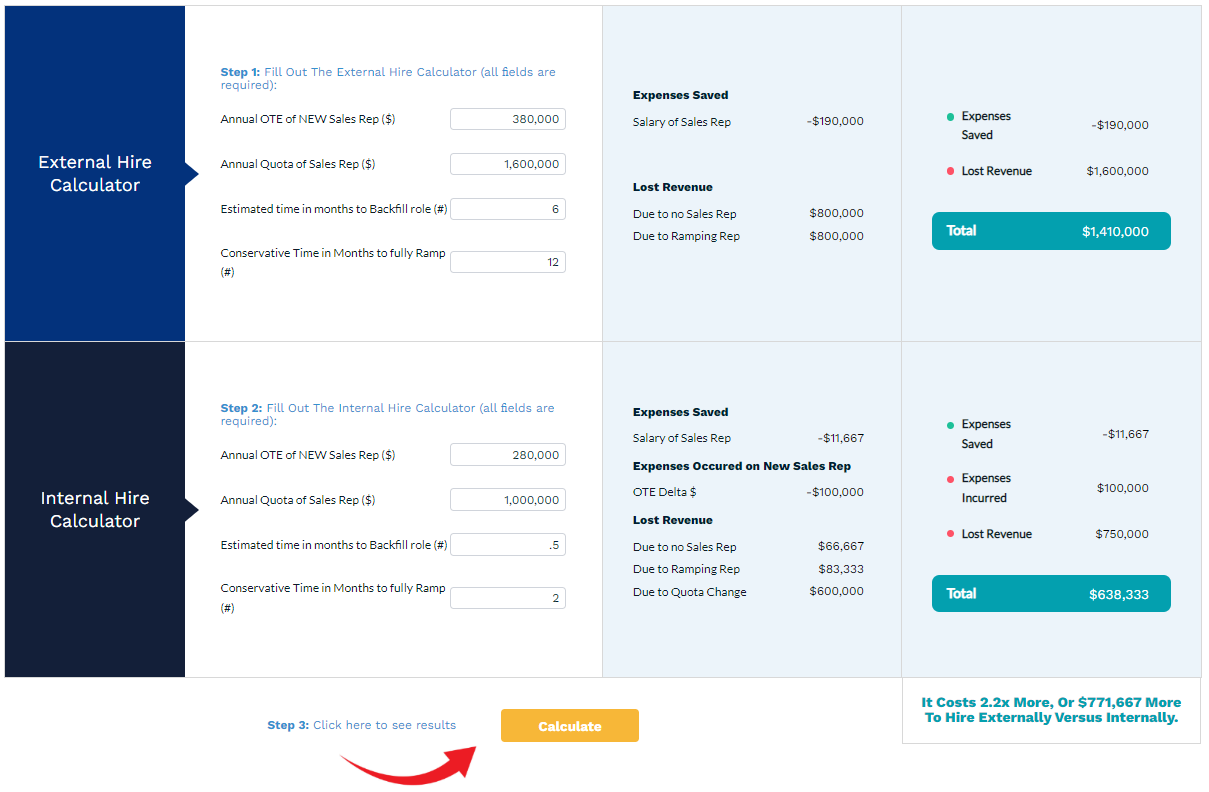
Turnover Happens
4 May 22What's the hiring strategy that makes the most sense for your business?
One of the biggest challenges any sales organization encounters is the turnover of a quota bearing sales rep. In a Q1 2022 study by SBI, seller attrition rates hovered around ~27%, on average, where 15% to 20% was the historical range. Whether voluntary or involuntary; the company has lost a quota bearing, revenue producing individual, and every moment that position is empty, less revenue is generated, and it becomes harder for the company to make its number.
When backfilling attrited talent or adding growth roles, most companies prioritize hiring external A-players. However, our modeling shows that most of the time—and wherever possible—new hires should come from within the organization. The cost of downtime is TOO much not to have a rep ready to go. We will examine the components of hiring an internal versus external hire and introduce SBI’s turnover calculator to help you determine which strategy is financially better for the company.
Internal Hire
Replacement Rep from a Bench: A Bench is an idea that you have a fully ramped sales rep ready to slide into any position when there is turnover. A bench rep is not quota bearing, does not have an assigned territory, but they are not sitting idle. They will onboard and ramp like any new sales rep, then assigned tasks where the company needs assistance. Example activities include: shadowing calls, partnering on opportunities and deals, playing a role in the deal desk, temporary SDR, assisting with enablement or revenue operations, vacation filler rep, or working on a backlog of projects.
Replacing a sales rep with an existing bench resource:
- The time to hire = 0
- Time to ramp = 0
- Loss of revenue = 0 or minimal
Replacement Rep from another Team: Promoting from within, but from another team or different role, the transition won't be as fast as someone on the bench, but you already have vetted an individual, they know the culture of the organization, and likely have familiarity with the sales process and team.
Even if the person being promoted has to take a reduced quota because they are not qualified to take on the full quota, the reduction remains better than the total cost of an external hire.
In doing so, you have created a career path, which is valuable to employees as they evaluate potential career options. Also, it is possible to have a Bench and a career progression such as moving from a junior role to the Bench.
Replacing a sales rep with a current hire on another team:
- Time to hire = 1–2 weeks
- Time to ramp = 1–2 weeks
- Loss of revenue = reduced
External Hire
Replacement Rep from outside the Company: An external hire means posting the open position, waiting for applications, and running the entire hiring process. It is a long process with a large opportunity cost.
Replacing a sales rep with an external hire:
- Time to hire = 6.2 months
- Time to ramp = 4 quarters (fully ramp)
- Loss of revenue = significant
One positive aspect of replacing with an external hire is that it eases the path forward for any change management initiatives such as processes or culture. Another advantage is you can hire a specialist or someone with skills in a certain vertical or a geography that doesn’t currently exist on the sales team which can open new market potential.
Recommendation
Counter to what most sales leaders might believe, and barring other unique considerations, the data suggests retention and training of an underperforming rep is less costly than an external hire. Be prepared for quota-bearing employee attrition by keeping a small number of junior or bench reps ready to step in during a time of need. While this option takes a certain amount of investment, there is a clear payoff.
SBI created a tool to help companies identify the true cost of replacing a sales rep with both an external hire and an internal hire. Use the turnover calculator to determine your organization’s opportunity cost as you plan your current sales talent, hiring strategy, and professional development.

